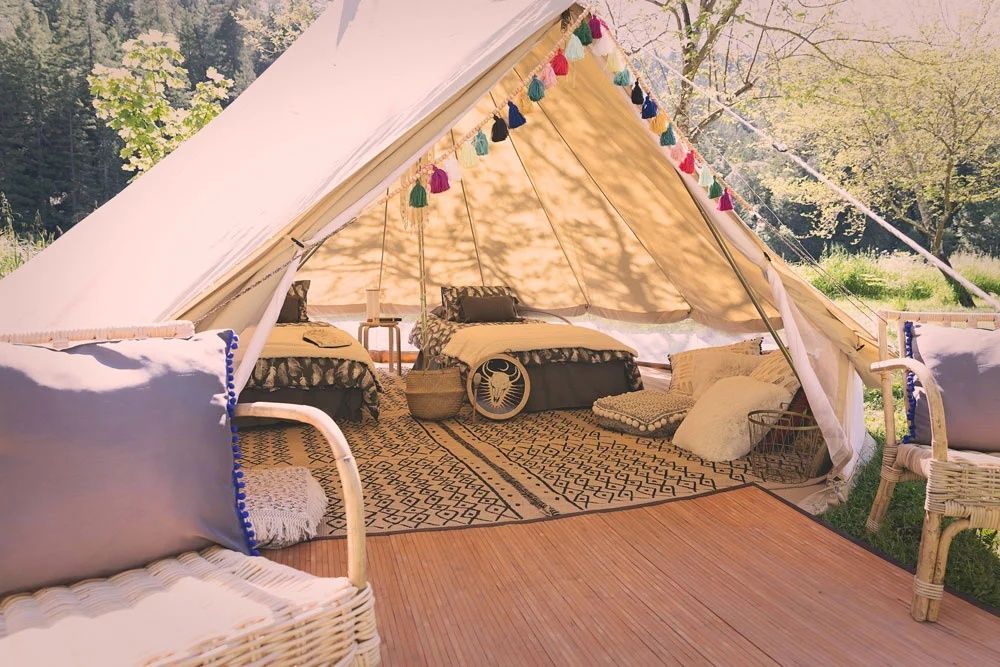Glamping, small for "glamorous camping", is a form of external habitat that combines nature's beauty with modern comfort. Unlike traditional camps, where passengers often rely on tents and minimal equipment, unique layouts such as glamping yottles, tritheous, safe tent, double and even provide luxury cabins.
This concept exists because people want the benefits of external experiences wind, visible landscape and nature discharge without waiving comfort and convenience. Glamping is especially appealing for those who like the journey, but prefer to rub, comfortable beds on minimal conditions, climate control and private bathrooms.
Importance
Due to many reasons, modern travel has become an important trend:
-
Access to all passengers: Unlike traditional camps, glamping provides comfort that makes outdoor families, old travelers and more attractive to the new ones.
-
Relationship with nature: It allows people to spend time in forests, mountains or coastal areas that enjoy modern facilities.
-
Sustainable journeys: Many glamping sites include environmentally friendly design, renewable energy and local materials, making them more in line with responsible tourism.
-
Stress reduction: With resting the risk to nature, it helps passengers to relax without worrying about the practical difficulties of the camp.
Glamping solves the problem of balanced nature release with the plant. It builds the gap between camps and hotels, creating a unique experience that appeals to a wide audience.
Newer Updates
The glamping sector has experienced rapid change over the past year:
-
Increasing demand for environmentally friendly stages (2024): Passengers are looking for a fast solar energy, a chicken chicken system and housing operated by natural structural materials.
-
Technology integration (2024–2025): Smart lighting, Wi-Fi outside the web and app-based ordering platforms have increased glamping experience.
-
Increase of theme stays (2025): Many destinations now offer unique layouts such as stargazing dome, wineyard lodge or wellness-centenary retreat.
-
Preferences after the pandemic (2024): Guests affect private, small-scale housing on crowded resorts, which are popular.
-
Extension in Asia-Pacific (2025): Countries such as Japan, Thailand and Australia have reported an increase in trips, which provides variation in traditional western markets.
Reports suggest that the global glamping market is ready to grow continuously through 2030, supported by both luxurious travelers and young adventurers.
Laws or Guidelines
Glamping is subject to different rules based on land or region. Common areas for regulation include:
-
Regulation and law on land use: Many governments regulate how flashing structures can be constructed, especially in environmentally sensitive areas.
-
Environmental protection rules: Places often require permits to ensure the minimum impact on wildlife, water resources and forests.
-
Fire safety and building code: Structures such as tents and domes shall meet safety rules, including escape passage and fire-resistant materials.
-
Travel license: In many areas, operators should register as official housing and follow hospitality standards.
-
Stability policy: Some countries provide encouragement to environmentally friendly glamping that use renewable energy or promote protection.
For travelers, these laws help ensure safety, reliability and environmental responsibility for provoking experiences.
Tools and Resources
Many tools and platforms can help passengers plan and order the right glamping trip:
-
Glamping Directory: Sites that show houses by field and style, allowing simple comparisons.
-
Travel planning apps: Tools such as Google Maps, Rome2rio or Komoot assist plan routes in remained places.
-
Weather trackers: Apps like Accuweather or Windy provide real-time updates, which are useful for outdoor-based visits.
-
Package list: Passengers on the online template can guide passengers to prepare clothing, essential goods and gears.
-
Sustainability certification: To identify environmentally responsible glamping sites, find an eco-label such as Green or LEED.
Questions to Ask
What is the difference between the camp and the glow?
Camping typically involves installing your own tent and using minimal equipment, while glamping provides prepared homes with modern comfort such as beds, heating and private bathrooms.
Do glamping sites usually have power and internet?
Many shiny homes provide electricity, heating and Wi-Fi, although accessibility varies by site. Distance eco-site can rely on solar energy and provide limited connection.
Is family-friendly?
Yes, glamping is popular with families, as it offers external experiences for children and adults, and provides rest, safety and convenience.
What should I pack for a great journey?
While most important items are provided, it is recommended to bring books or games such as outerwear, personal toilet, insect disorders, a flashlight and entertainment.
Is that glamping environmentally durable?
Many bright places focus on stability when using environmentally friendly materials, renewable energy and local purchases. However, environmental practice is different, so it is best to do research before ordering.
Conclusion
Glamping represents a modern way of contacting nature without giving comfort. This is present because travelers want unique external experiences that balance adventure work with convenience.
The meaning provides access, stability and stress maintenance.
With newer innovations such as theme cormorants, environmentally friendly design and digital ordering platforms, glamping continues. Rules ensure safety and environmental protection, while equipment and resource planning make planning much easier than ever.